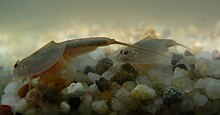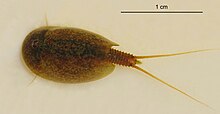The order Notostraca, containing the single family Triopsidae, is a group of crustaceans known as tadpole shrimp[1] or shield shrimp.[2] The two genera, Triops and Lepidurus, are considered living fossils, with similar forms having existed since the end of the Devonian, around 360 million years ago. They have a broad, flat carapace, which conceals the head and bears a single pair of compound eyes. The abdomen is long, appears to be segmented and bears numerous pairs of flattened legs. The telson is flanked by a pair of long, thin caudal rami. Phenotypic plasticity within taxa makes species-level identification difficult, and is further compounded by variation in the mode of reproduction. Notostracans are omnivores living on the bottom of temporary pools and shallow lakes.
| Notostraca Temporal range:
| |
|---|---|

| |
| Triops australiensis | |

| |
| Lepidurus apus | |
| Scientific classification | |
| Domain: | Eukaryota |
| Kingdom: | Animalia |
| Phylum: | Arthropoda |
| Class: | Branchiopoda |
| Superorder: | Calmanostraca |
| Order: | Notostraca G. O. Sars, 1867 |
| Genera | |
Description
editNotostracans are 2–5 centimetres (0.8–2.0 in) long, with a broad carapace at the front end, and a long, slender abdomen.[1] This gives them a similar overall shape to a tadpole, from which the common name tadpole shrimp derives.[1] The carapace is dorso-ventrally flattened, smooth, and bears no rostrum; it includes the head, and the two sessile compound eyes are located together on top of the head.[1] The two pairs of antennae are much reduced, with the second pair sometimes missing altogether.[2] The mouthparts comprise a pair of uniramous mandibles and no maxillipeds.[2]
The trunk consists of three regions; thorax I, thorax II and the abdomen. Thorax I is made up of 11 segments, each with a pair of well-developed limbs and the genital opening on the eleventh segment. In the female, it is modified to form a "brood pouch".[3] The first one or two pairs of legs differ from the remainder, and probably function as sensory organs.[3]
The somites on thorax II are fused into "rings", which varies in number between species and gender and appear to be body segments, but do not always reflect the underlying segmentation.[1] Each ring is made up of 2–6 complete or partial fused segments, and the number of legs on each body ring match its number of segments.[4][1] The legs become progressively smaller posteriorly,[3] with the last segments being legless.[1]
The limbless abdomen ends in a telson and a pair of long, thin, multi-articulate caudal rami.[5] The form of the telson varies between the two genera: in Lepidurus, a rounded projection extends between the caudal rami, while in Triops there is no such projection.[1]
Life cycle
editWithin the Notostraca, and even within species, there is variation in the mode of reproduction, with some populations reproducing sexually, some showing self-fertilisation of females, and some showing a mix of the two.[1][6] The frequency of males in populations is therefore highly variable.[3] In sexual populations, the sperm leave the male's body through simple pores, there being no penis. The eggs are released by the female and then held in the cup-like brood pouch.[3] The eggs are retained by the female only for a short time before being laid,[7] and the larvae develop directly, without passing through a metamorphosis.[2]
Ecology and distribution
editNotostracans are omnivorous, eating small animals such as fishes and fairy shrimp.[1] They are found worldwide in freshwater, brackish water, or saline pools, as well as in shallow lakes, peat bogs, and moorland.[2] The species Triops longicaudatus is considered an agricultural pest in California rice paddies, because it prevents light from reaching the rice seedlings by stirring up sediment.[8]
Evolution and fossil record
editThe fossil record of Notostraca is extensive, occurring in a wide range of geological deposits.[9] The oldest known notostracan is the species Strudops goldenbergi from the Late Devonian (Famennian ~ 365 million years ago) of Belgium.[10] The lack of major morphological change since 250 million years ago has led to Notostraca being described as living fossils.[11] Kazacharthra, a group known only from Triassic and Jurassic fossils from Kazakhstan and Western China,[12] are closely related to notostracans, and may belong within the order Notostraca,[13] or alternatively are placed as their sister group within the clade Calmanostraca.
The "central autapomorphy" of the Notostraca is the abandonment of filter feeding in open water, and the development of a benthic lifestyle in muddy waters, taking up food from particles of sediment and preying on small animals.[7] A number of other characteristics are correlated with this change, including the increased size of the animal compared to its relatives, and the loss of the ability to hinge the carapace; although a central keel marks the former separation into two valves, the adductor muscle is missing.[7] Notostracans retain the plesiomorphic condition of having two separate compound eyes, which abut, but have not become united, as seen in other groups of Branchiopoda.[7]
Taxonomy
editThe extant members of order Notostraca composed a single family, Triopsidae, with only two genera, Triops and Lepidurus.[11] The problematic Middle Ordovician fossil Douglasocaris has been erected and placed in its own family Douglasocaridae by Caster & Brooks 1956, and may be ancestral to Notostraca.
The phenotypic plasticity shown by notostracan species make identification to the species level difficult.[11] Many putative species have been described based on morphological variation, such that by the 1950s, as many as 70 species were recognised.[11] Two important revisions – those of Linder in 1952[14] and Longhurst in 1955[15] – synonymised many taxa, and resulted in the recognition of only 11 species in the two genera. This taxonomy was accepted for decades,[11] "even attaining the status of dogma".[16] More recent studies, especially those employing molecular phylogenetics, have shown that the eleven currently recognised species conceal a greater number of reproductively isolated populations.[11]
Genera list
edit- Apudites, (Formerly "Notostraca" minor, often referred to as Triops cancriformis minor, or "Triops" minor in historic literature) Lower Triassic, Grès à Voltzia, Vosges Mountains, France; Hassberge Formation, Germany, Late Triassic (Carnian)[17][18]
- Brachygastriops Dabeigou Formation, China, Late Jurassic or Early Cretaceous
- Chenops Yixian Formation, China, Early Cretaceous (Aptian)
- Dikelocephala, Lower Triassic of North China
- Discocephala, Lower Triassic of North China
- Heidiops, Lower Permian of the Lodève Basin, France[19]
- Jeholops Yixian Formation, China, Early Cretaceous (Aptian)
- Lynceites Germany, Canada, Carboniferous
- Prolepidurus, Late Jurassic?-Lower Cretaceous, Transbaikal, Russia
- Strudops Strud locality, Belgium, late Devonian (Fammenian)
- Thuringiops, Upper Oberhof Formation, Thuringian Forest Basin, Germany[19]
- Weichangiops Dabeigou Formation, China, Late Jurassic or Early Cretaceous
- Xinjiangiops Kelamayi Formation, China, Middle Triassic
Incertae sedis species
See also
editReferences
edit- ^ a b c d e f g h i j Denton Belk (2007). "Branchiopoda". In Sol Felty Light; James T. Carlton (eds.). The Light and Smith Manual: Intertidal Invertebrates from Central California to Oregon (4th ed.). University of California Press. pp. 414–417. ISBN 978-0-520-23939-5.
- ^ a b c d e J. K. Lowry (October 2, 1999). "Notostraca (Branchiopoda)". Crustacea, the Higher Taxa: Description, Identification, and Information Retrieval. Archived from the original on July 23, 2011. Retrieved February 7, 2011.
- ^ a b c d e Douglas Grant Smith (2001). Pennak's freshwater invertebrates of the United States: Porifera to Crustacea (4th ed.). John Wiley and Sons. ISBN 978-0-471-35837-4.
- ^ Evolution and Phylogeny of Pancrustacea: A Story of Scientific Method - 44. Notostraca and Allies (Calmanostraca)
- ^ "Subclass 1. Branchiopoda". The Invertebrata (4th ed.). Cambridge University Press. 1961. pp. 368–375.
- ^ Self-Fertilization and the Role of Males in Populations of Tadpole Shrimp (Branchiopoda: Notostraca: Triops)
- ^ a b c d Peter Ax (2000). "Notostraca". Multicellular Animals. The Phylogenetic System of the Metazoa. Volume II. Springer. pp. 158–159. ISBN 978-3-540-67406-1.
- ^ Clifford, Hugh F. (1991). "Notostraca: Tadpole shrimp". Aquatic Invertebrates of Alberta: An illustrated guide. University of Alberta. pp. 144–145. ISBN 978-0-88864-234-9.
- ^ Atte Korhola & Milla Rautio (2001). "Cladocera and other branchiopod crustaceans". In John P. Smol; Harry John Betteley Birks & William M. Last (eds.). Tracking Environmental Change Using Lake Sediments. Volume 4: Zoological Indicators. Kluwer Academic Publishers. pp. 5–41. ISBN 978-1-4020-0658-6.
- ^ Lagebro, Linda; Gueriau, Pierre; Hegna, Thomas A.; Rabet, Nicolas; Butler, Aodhán D.; Budd, Graham E. (May 2015). Korn, Dieter (ed.). "The oldest notostracan (Upper Devonian Strud locality, Belgium)". Palaeontology. 58 (3): 497–509. Bibcode:2015Palgy..58..497L. doi:10.1111/pala.12155. ISSN 0031-0239. S2CID 129231634.
- ^ a b c d e f Luc Brendonck; D. Christopher Rogers; Jorgen Olesen; Stephen Weeks & Walter R. Hoch (2008). "Global diversity of large branchiopods (Crustacea: Branchiopoda) in freshwater". In Estelle V. Balian; Christian Lévêque; Hendrik Segers & Koen Martens (eds.). Freshwater Animal Diversity Assessment. Developments in Hydrobiology 198. Vol. 595. pp. 167–176. doi:10.1007/s10750-007-9119-9. ISBN 978-1-4020-8258-0. S2CID 46608816.
{{cite book}}:|journal=ignored (help) - ^ Liu, Hongfu (1996). "New materials of Late Triassic Kazacharthra from Xinjaing". Acta Palaeontologica Sinica. 4 (35): 490–494. Archived from the original on 2013-04-14.
- ^ Marjorie L. Reaka-Kudla (2002). "Habitat specialization and its relation to conservation policy in Crustacea". In Elva Escobar-Briones; Fernando Alvarez (eds.). Modern Approaches to the Study of Crustacea. Springer. pp. 211–221. ISBN 978-0-306-47366-1.
- ^ Folke Linder (1952). "Contributions to the morphology and taxonomy of the Branchiopoda Notostraca, with special reference to the North American species". Proceedings of the United States National Museum. 102 (3291): 1–69. doi:10.5479/si.00963801.102-3291.1.
- ^ Alan R. Longhurst (1955). "A review of the Notostraca". Bulletin of the British Museum (Natural History). 3 (1): 1–57. doi:10.5962/bhl.part.4119.
- ^ Clay Sassaman; Marie A. Simovich & Michael Fugate (1997). "Reproductive isolation and genetic differentiation in North American species of Triops (Crustacea: Branchiopoda: Notostraca)". Hydrobiologia. 359 (1–3): 125–147. doi:10.1023/A:1003168416080. S2CID 6767325.
- ^ Wagner, Philipp; Haug, Joachim T.; Sell, Jürgen; Haug, Carolin (December 2017). "Ontogenetic sequence comparison of extant and fossil tadpole shrimps: no support for the "living fossil" concept". PalZ. 91 (4): 463–472. Bibcode:2017PalZ...91..463W. doi:10.1007/s12542-017-0370-8. ISSN 0031-0220. S2CID 90922613.
- ^ Geyer, Gerd; Hegna, Thomas A.; Kelber, Klaus-Peter (2024). "The end of the 'living fossil' tale? A new look at Triassic specimens assigned to the tadpole shrimp Triops cancriformis (Notostraca) and associated phyllopods from the Vosges region (eastern France)". Papers in Paleontology. 10 (5). e1589. doi:10.1002/spp2.1589.
- ^ a b Werneburg, R.; Schneider, J. W. (2023). "New branchiopod crustaceans from the late Carboniferous and early Permian of the Thuringian Forest Basin, Germany, with a review of Permian notostracans from the Lodève basin, France". Semana. 37: 57–103.
- ^ a b Wagner, Philipp; Haug, Joachim T.; Haug, Carolin (December 2019). "A new calmanostracan crustacean species from the Cretaceous Yixian Formation and a simple approach for differentiating fossil tadpole shrimps and their relatives". Zoological Letters. 5 (1): 20. doi:10.1186/s40851-019-0136-0. ISSN 2056-306X. PMC 6582493. PMID 31245037.
External links
edit- Triops cancriformis media from ARKive
- L. D. Godfrey & L. A. Espino (February 2009). "Tadpole shrimp. Scientific name: Triops longicaudatus". UC Pest Management Guidelines. University of California, Davis.